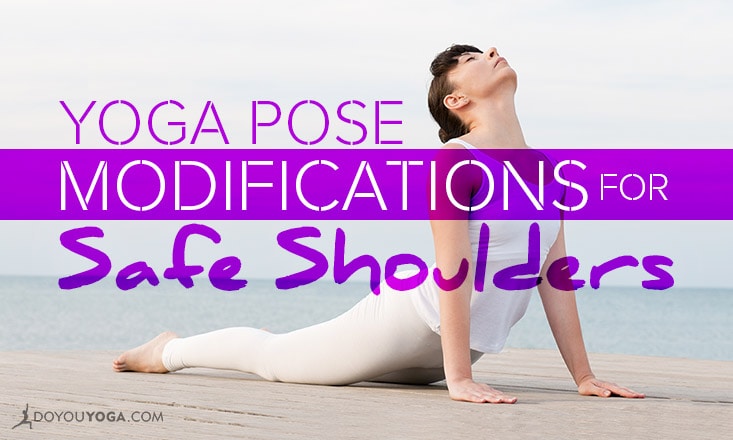Do you carry the weight of the world on your shoulders?
The truth of this saying shows up in practically every yoga class, as inevitability, at least one student will tell me of a history of shoulder pain and/or injury that has either led them to yoga, or that has been caused by practicing yoga with poor alignment.
Brief Anatomy of the Shoulder
Four joints in total make up the many movements of the shoulder and shoulder blade (scapula), the most flexible joint in the entire body. For the purpose of this article let's just focus on the glenohumeral joint because the root of many yoga related shoulder problems begins here.
This ball and socket joint is responsible for frontal abduction, horizontal adduction, extension, and flexion, and internal and external rotation forms from the union of the humerus (upper arm bone) and scapula.
Within the scapula, the glenoid fossa, supported by cartilage known as the labrum and the four muscles of the rotator cuff, allows circular movement of the arm and prevents the arm bone from dislocating from the scapula.
Over time, especially during active Vinyasa practices, overuse can break down these muscles, creating chronic pain which leads to injuries that can force you to take a lengthy vacation from yoga.
Below are five helpful yoga pose modifications to help prevent shoulder injury and pain and/or speed up the healing process for injured shoulders.
1. Ease off the Vinyasa.
 Credit: Anna Coventry
Credit: Anna Coventry Occasionally, mix up the repetitive Chaturanga, Upward Dog, Downward Dog combo. You can attend a less vigorous class, do some Moon Salutations to add more leg work and variety, or you can modify within the Vinyasa by pausing in Child's Pose.
Depending on the class style and teacher, you may end up doing 30 or more of these weight-bearing Vinyasa. Trust me—your shoulders will thank you for the extra love in the long run.
2. Open your Warrior heart.
 Credit: MSN
Credit: MSNThe shoulders tend to pick up the slack of a tight chest. When these muscles are shortened, the amount of stress they can handle is compromised. Spending long hours in a seated position at work, cycling, or just chilling on the sofa can contribute to solidifying your body in this rounded hunched over posture.
A simple solution is externally rotating the shoulders so the palms face up in Warrior II. You will alleviate tension and find access to more muscle power in the upper body which means LESS STRAIN on the neck, shoulders, and upper back.
3. Prop up your forearm work.
 Credit: Yoga Teacher Central
Credit: Yoga Teacher CentralForearm Plank, Pincha Mayurasana, and Scorpion require plenty of shoulder stability and when done correctly boast tremendous healing capabilities.
However, when we place the body weight on the arms in this way, without the proper amount of strength in the chest and latissimus dorsi, the elbows gradually widen, which unreasonably asks the shoulders to do more than their share of work.
When the shoulder is continually fatigued in this way, the risk of injury greatly increases. In recent years, a concept known as Triangle Forearm Support emerged as a method to help alleviate pain in the rotator cuff associated with excessive overhead motion.
Enlist Triangle Forearm Support and keep the elbows at the optimal shoulder width distance by wrapping a strap around the arms and placing a block between the first finger and thumbs for added support.
And, when in doubt of your ability to maintain your balance, always use the wall for these inversions.
4. Check your Chaturanga.
 Credit: YogaHara
Credit: YogaHaraAligning your shoulders at a strict 90-degree angle when doing your yoga pushup will enable optimal scapular stabilization. You will recruit core muscle groups, the chest, and the triceps for help rather than depending on the shoulder to bear all the weight.
If you have a habit of dipping too low here, practice with your knees down until you feel more confident about this pose. As an added benefit, your ability to safely execute this pose will make other arm balances more accessible so the extra attention will help you take you practice to the next level.
5. Spread your wings.
 Credit: Complete Yoga
Credit: Complete YogaThe "wing" muscle, the latissimus dorsi gets this name because it is the broadest muscle in the body. With the big responsibility of stabilizing the scapula and keeping you out of your trapezius, this muscle often tends to be underused and thus weakened.
Put simply, if you used the lats more, you will use the shoulders less, and that is a good thing! So how can you activate these muscles in your yoga practice?
Extended Hand-to-Big-Toe Pose can help you feel your way into this muscle. Make sure to bend the elbow of the arm that is holding the toe, and pull your arm toward the torso. You will get a little bicep action and some scapular depression here as well to really turn those lats on!
The complexities of the shoulder cannot be fully described in this article; however, remembering a few simple rules when practicing yoga will help you protect your shoulders and strengthen the surrounding muscles groups.
With stability as your goal, try to use your neck less and your chest muscles and latissimus dorsi more during active postures. You will not only improve the overall efficiency of your practice, you will also ensure that you can keep getting on your mat injury free.
Stay present to your limits and allow your yoga to evolve!


